Compiled by Tom Lake, Hudson River Estuary Program Consulting Naturalist
Overview
As a harbinger of things to come, at least two seals patrolled the upper end of tidewater this week, waiting for the soon-to-arrive river herring from the sea. Several bald eagle nests were on the brink of having egg hatches and our glass eel season was already showing robust numbers in fyke nets set in tributaries.
Highlight of the Week
3/22 – Montgomery County, HRM 157: It was a week of visitors from Canada at Fultonville. We found three neck-banded Canada geese within five miles of our home on the Mohawk River and reported them to a band-reporting resource.
Two of the banded geese were together in a flock of about fifteen-hundred birds. Although they had different colored bands, both were banded by the same researcher in the same area in Varennes, Quebec, Canada. One was a 13-year-old female, the other a 12-year-old male. The third banded goose, a male, was spotted in the pouring rain in front of a McDonald's restaurant in Fultonville. He was a mere youngster at seven-years-old and had been banded within a few yards of a Tim Horton's coffee shop in Quebec.
- Marianne Friers
Natural History Entries
3/16 – Staatsburg, HRM 87: While walking one of the trails at the south end of Mills Cove this morning, I came upon a partially eaten fish that was missing its tail. The forward two-thirds of the fish measured four-inches. The fish was solidly frozen in the ice of the trail, so something must have lost its meal yesterday when the air was warmer and some thawing had occurred.
- David Lund
[The fish was a brown bullhead (Ameiurus nebulosus). The easy answer as to “Who did it,” would be a bald eagle. While it seemed odd that the raptor would leave two-thirds of a catfish behind, eagles are known to be fickle feeders and often do not consume all of what they catch. Tom Lake]
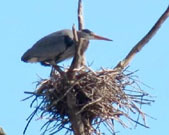 3/16 – Bedford, HRM 35: I checked out the great blue heron rookery for the first time today and found seven herons standing guard and one settled down in a nest with just its bill showing. This may indicate that egg laying had begun. Herons typically lay two-to-five eggs and begin incubating right after the first egg is laid. The single herons were very likely males guarding the nests they had selected and were waiting for their mates to show up. In the coming weeks, there will be more activity as more herons arrive. (Photo of great blue heron courtesy of Jim Steck) 3/16 – Bedford, HRM 35: I checked out the great blue heron rookery for the first time today and found seven herons standing guard and one settled down in a nest with just its bill showing. This may indicate that egg laying had begun. Herons typically lay two-to-five eggs and begin incubating right after the first egg is laid. The single herons were very likely males guarding the nests they had selected and were waiting for their mates to show up. In the coming weeks, there will be more activity as more herons arrive. (Photo of great blue heron courtesy of Jim Steck)
- Jim Steck
3/16 – Rockland County, HRM 33: Bald eagle nest NY336 still looks good for incubation. One adult was moving around today and then settled down in the nest.
- Chris Galligan
 3/17 – Fort Edward, HRM 202: We searched for raptors and waterfowl today at the Fort Edward Grasslands. We found plenty of ducks and Canada geese as well as several each of rough-legged hawks, red-tailed hawks, northern harriers, turkey vultures, American kestrels and bald eagles. The highlight of our trip was Heidi's keen eyes catching an all-white raptor from an extremely long distance. We traveled, searching, for two hours and finally found it: a leucistic red-tailed hawk. It was stunning! (Photo of red-tailed hawk (leucistic) courtesy of Heidi Nicholson) 3/17 – Fort Edward, HRM 202: We searched for raptors and waterfowl today at the Fort Edward Grasslands. We found plenty of ducks and Canada geese as well as several each of rough-legged hawks, red-tailed hawks, northern harriers, turkey vultures, American kestrels and bald eagles. The highlight of our trip was Heidi's keen eyes catching an all-white raptor from an extremely long distance. We traveled, searching, for two hours and finally found it: a leucistic red-tailed hawk. It was stunning! (Photo of red-tailed hawk (leucistic) courtesy of Heidi Nicholson)
- Scott Varney, Heidi Nicholson (Hudson-Mohawk Bird Club)
 3/17 – Norrie Point, HRM 85: We saw a bird diving in the river yesterday in the south-side cove adjacent to the Norrie Point Environmental Education Center. We were fairly certain it was a grebe, and from the shape of the beak, it did not look like a pied-billed grebe. It was drifting in the sun's glare and then took off before we could get a good look. Today, walking a trail by the cabins at the campground, we saw what looked like the same bird at the north-side of the Indian Kill. The bird surfaced only ten-feet away. It was a horned grebe. It didn't seem too concerned that we were there as it slowly swam away. The grebe did not resume diving until we began to walk away. (Photo of horned grebe courtesy of Glenn Bartley) 3/17 – Norrie Point, HRM 85: We saw a bird diving in the river yesterday in the south-side cove adjacent to the Norrie Point Environmental Education Center. We were fairly certain it was a grebe, and from the shape of the beak, it did not look like a pied-billed grebe. It was drifting in the sun's glare and then took off before we could get a good look. Today, walking a trail by the cabins at the campground, we saw what looked like the same bird at the north-side of the Indian Kill. The bird surfaced only ten-feet away. It was a horned grebe. It didn't seem too concerned that we were there as it slowly swam away. The grebe did not resume diving until we began to walk away. (Photo of horned grebe courtesy of Glenn Bartley)
- David Lund, Linda Lund
3/17 – Rockland County, HRM 33: Congers Lake was bustling with waterfowl over the last two days: mute swans were paired off and displaying courtship signs; two swans appeared to be building a nest out of Phragmites along water’s edge; mallards were paired and swimming together; drake common mergansers were chasing hen mergansers with the lucky ones already swinging off alone in pairs. I counted at least 15 great blue herons along the eastern side of the lake.
- Chris Galligan
3/18 – Ulster County, HRM110: On March 2, Deb and Kevin Berry reported an unusual congregation of hundreds of eastern red-spotted newts in a thawed pothole of a frozen swamp in the Town of Windham. Our amphibian experts were stumped as to what it meant.
Jacob Kubel, Conservation Scientist, Natural Heritage & Endangered Species Program, Massachusetts Division of Fisheries & Wildlife, knew of this phenomenon that he called a “newt ball.” Jacob explained that the exact function of a newt ball is not known. Newts are cold-blooded, and so they are not clustering like small mammals or birds might do to conserve heat. However, whether many individuals compete to be in a particularly warm, localized area in the pond, and the result is a clustered mass of newts all trying to be in the same place, has not been ruled out. “Mating balls” of several individuals are known to occur, but not at the scale of scores to hundreds of individuals in a single mass, as in this instance. Regardless, newt clusters are a temporary phenomenon – there is evidence they may assemble for only days or weeks at a time, but no data to suggest they form a lasting “bond” through the winter. In fact, this may occur more commonly near the end of winter. Jeremy Feinberg and Kristen Bell Travis also contributed to this investigation.
- Tom Lake
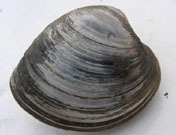 3/18 – Haverstraw Bay, HRM 38: Our DEC Hudson River Fisheries Unit crew was back on Haverstraw Bay for our juvenile sturgeon survey today. In addition to seven juvenile sturgeon caught, we collected many live clams in our net. (Photo of hard-shell clam courtesy of Matthew Baker) 3/18 – Haverstraw Bay, HRM 38: Our DEC Hudson River Fisheries Unit crew was back on Haverstraw Bay for our juvenile sturgeon survey today. In addition to seven juvenile sturgeon caught, we collected many live clams in our net. (Photo of hard-shell clam courtesy of Matthew Baker)
- Amanda Higgs
[Photos revealed that the bivalves were hard-shell clams (Mercenaria mercenaria), a common marine mollusk in the lower Hudson River estuary. Tom Lake]
*** Fish of the Week ***
With winter here and much of the watershed’s ponds, creeks, lakes, and rivers iced-over, many of us are going through fish withdrawal. As a coping device, until fully open water returns in April, we will have a “Fish of the Week” feature.
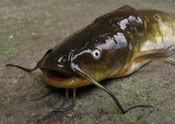 3/18 – Hudson River Watershed: This week’s fish is the brown bullhead (Ameiurus nebulosus), species number 77 (of 228) on our watershed list of fishes. (If you would like a copy of our list, e-mail: trlake7@aol.com.) 3/18 – Hudson River Watershed: This week’s fish is the brown bullhead (Ameiurus nebulosus), species number 77 (of 228) on our watershed list of fishes. (If you would like a copy of our list, e-mail: trlake7@aol.com.)
[Brown bullhead is a catfish native to the Hudson River watershed. They are one of eight members of their family (Ictaluridae) of bullhead catfishes and are found throughout New York State. They are a small species, rarely exceeding one-foot in length and feed primarily on Crustacea and small fishes. Tom Lake] (Photo of brown bullhead courtesy of Michael Kesl)
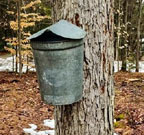 3/19 – Minerva, HRM 284: I drilled five sugar maples in the back yard a week ago when the weather grew warm, and I collected a half-gallon of sap. Then winter returned and the system froze up. The trees were standing there now, with buckets hanging, and nothing dripping. (Photo of maple sugaring in the ADKs courtesy of ADK-VIC) 3/19 – Minerva, HRM 284: I drilled five sugar maples in the back yard a week ago when the weather grew warm, and I collected a half-gallon of sap. Then winter returned and the system froze up. The trees were standing there now, with buckets hanging, and nothing dripping. (Photo of maple sugaring in the ADKs courtesy of ADK-VIC)
- Mike Corey
3/19 – Yonkers, HRM 18: On a sunny and mild afternoon, our 9-11 grade students from the Bio-Chem program at Saunders High School in Yonkers sampled our eel mop for glass eels and collected 19. The eel mop also held one elver (last year’s glass eel). The water temperature was 46 degrees Fahrenheit (F).
- Brenda Jandres
3/19 – Note: Last week we reported an eastern ribbon snake (Thamnophis sauritus) at River mile 44. After much discussion with herpetologists and reviewing photographs, it was decided that the snake was likely a garter snake (T. sirtalis), a close relative to and quite easily confused with the ribbon snake.
- Tom Lake
3/19 – Yonkers, HRM 18: We took another crack at seining in the river today, and once again, found nothing in our six hauls. We were, however, catching fish in our glass eel fyke net including mummichogs (Fundulus heteroclitus) along with huge numbers of glass eels. Today’s count was 332 eels.
- Elisa Caref, Jan Manosca
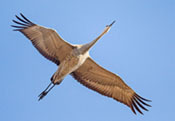 3/20 – Eastern Dutchess County, HRM 82: Our Wednesday field trip spotted a sandhill crane heading north in a flyover from the Harlem Valley Rail Trail near Wassaic. Sandhill cranes have nested in New York State since 2003 beginning near Montezuma National Wildlife Refuge. Since then, the sightings across the state have increased slowly in number and distribution, including Dutchess County. (Photo of sandhill crane courtesy of Melissa Groo) 3/20 – Eastern Dutchess County, HRM 82: Our Wednesday field trip spotted a sandhill crane heading north in a flyover from the Harlem Valley Rail Trail near Wassaic. Sandhill cranes have nested in New York State since 2003 beginning near Montezuma National Wildlife Refuge. Since then, the sightings across the state have increased slowly in number and distribution, including Dutchess County. (Photo of sandhill crane courtesy of Melissa Groo)
- Barbara Butler (Ralph T. Waterman Bird Club)
3/20 – Hudson River watershed: On today’s Vernal Equinox, we began the twenty-sixth year of our Hudson River Almanac. The Almanac began in 1994 as a modest public forum for sharing stories, ideas and adventures from the High Peaks of the Adirondacks, 320 miles upstream, to the sea. Our intention has been to document events that define the seasons. The Almanac has since grown (endured) to a distribution list of more than 20,000, featuring photographs and a range of contributions from elementary school poetry to the proclamations of scientists.
- Tom Lake.
3/20 – Croton Point, HRM 34: We had our first common snipe sighting of the season this morning at Croton Point. I am sure there soon will be more. Other wildlife counted on a Sawmill River Audubon walk included five American woodcock, two coyotes on the landfill, and a great horned owl.
- Larry Trachtenberg, Charlie Roberto
3/20 – Manhattan, HRM 1: We checked our research sampling gear in Hudson River Park at The River Project's sampling station on the lighthouse tender Lilac at Pier 25 and were rewarded with a tiny immature blue crab, 15 millimeters (mm) point-to-point across its carapace. Our eel mop produced our first fish of 2019, an adorable 51.0 (mm) naked goby (Gobiosoma bosc).
- Siddhartha Hayes, Toland Kister
[Note: one inch = 25.4 millimeters (mm)]
3/21 – Hudson River, HRM 145-132: Last week’s harp seal as well as a harbor seal were still being sighted in the Hudson River between New Baltimore and Albany. An updated protocol was released this week from Maxine Montello, Rescue Program Director, Riverhead Foundation for Marine Research and Preservation to help, if you come upon a seal, document the presence of these marine mammals in the Hudson River.
- To report a sick or injured marine mammal or sea turtle, please call the New York State 24-hour Hotline at (631) 369-9829. If you have photos or videos of live marine mammals or sea turtles, please send them to sightings@riverheadfoundation.org. If you have photos or videos of deceased marine mammals or sea turtles, please send them to sightings@amseas.org.
[Marine mammals began visiting the Hudson River estuary following the Ice Age and after the retreat of glacial ice from the Hudson Valley about 13,000 years ago. With lower sea levels, it took a while for the ocean waters to find the lower river, but not long after the first of us arrived, about 12,000 years ago, marine mammals were likely quite common. Tom Lake
[The list of Hudson River estuary marine mammals documented in the Hudson River Almanac across the last 25 years includes:
- harbor seal (Phoca vitulina)
- hooded seal (Cystophora cristata)
- gray seal (Halichoerus grypus)
- harp seal (Pagophilus groenlandicus)
- common (harbor) porpoise (Phocoena phocoena)
- Risso’s dolphin (Grampus griseus)
- bottlenose (common) dolphin (Tursiops truncatus)
- Florida manatee-2006 (Trichechus manatus latirostris)
- minke whale-2007 (Balaenoptera acutorostrata)
- humpback whale-2016 (Megaptera novaeangliae).
3/21 – Saugerties, HRM 102: I checked a local road in the Town of Saugerties after dark and found a relatively small movement of amphibians heading to their breeding pools. Over the course of 90 minutes, I encountered three Jefferson/blue-spotted salamanders, 15 red-spotted salamanders, and four four-toed salamanders. Oddly, there were no frogs seen or heard on or near the roadway this night.
- Steve Chorvas
3/21 – Yonkers, HRM 18: On a cool, rainy afternoon, our 9-11 grade students from the Bio-Chem program at Saunders High School in Yonkers sampled our eel mop for glass eels and collected 21. The eel mop also held one elver (last year’s glass eel). The water temperature was 47 degrees F.
- Brenda Jandres
3/21 – Town of Poughkeepsie: On February 22, nest monitor Bob Rightmyer went out on a limb and proclaimed the start of incubation for bald eagle nest NY62. We estimate the start of incubation purely from observations of adult behavior seriously attending to and covering eggs. A more precise start date is often determined by backing up 32-35 days from when we sense the first hatch has occurred. Using Bob Rightmyer’s educated guess, we might see a hatch at NY62 around March 26-29.
- Tom Lake
 3/22 – Yonkers, HRM 18: This was another very productive day for capturing glass eels in from the sea. Today’s tally at the Beczak Center was 181 eels, bringing our total for the week to 1,207. Our one-day high count came yesterday at 644. We also caught two larval and one immature winter flounder in the fyke net. (Photo of winter flounder courtesy of Joe Reynolds) 3/22 – Yonkers, HRM 18: This was another very productive day for capturing glass eels in from the sea. Today’s tally at the Beczak Center was 181 eels, bringing our total for the week to 1,207. Our one-day high count came yesterday at 644. We also caught two larval and one immature winter flounder in the fyke net. (Photo of winter flounder courtesy of Joe Reynolds)
- Elisa Caref, Jan Manosca
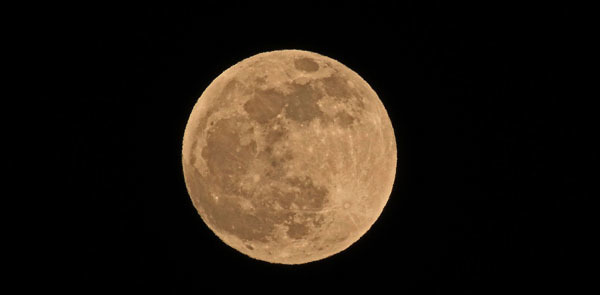
Spring- Summer 2019 Natural History Programs
Wednesday, July 10 - Thursday July 11 (9:00 AM - 5:00 PM)
2019 Teachers on the Estuary and Living Environment Institute
Wonders of Wetlands (15 credit hours for NYS certified teachers and administrators)
Five Rivers Environmental Education Center, 56 Game Farm Road, Delmar, New York
Join us this summer as we explore the Wonders of Wetlands. Teachers will spend two days gaining valuable knowledge and learning new curricula. We will use interdisciplinary approaches with the guidance of experts like EPA Award Winner Chris Bowser.
Cost: $50.00 for materials, supplies, and refreshments (light dinner on Thursday)
To register, e-mail drew.hopkins@dec.ny.gov
Tuesday, August 20 - Thursday August 22 (9:00 AM - 4:00 PM)
2019 Teachers on the Estuary and Living Environment Institute
Amazing Watersheds (22 credit hours for NYS certified teachers and administrators)
Five Rivers Environmental Education Center, 56 Game Farm Road, Delmar, New York
Join us this summer as we explore amazing watersheds. Teachers will spend three days gaining valuable knowledge and learning new curricula while using interdisciplinary approaches to explore watersheds. Some easy hiking on trails is involved.
Cost: $60.00 for materials, supplies, and refreshments (dinner provided on Wednesday)
To register, e-mail drew.hopkins@dec.ny.gov
Volunteer Opportunity: Hudson River Eel Project
We are seeking volunteers to help study eels in streams of the Hudson River estuary! Volunteers check specialized nets for young transparent "glass eels" as they enter freshwater from their spawning grounds over 1,000 miles away in the Atlantic Ocean. Eels are counted, weighed, and released upstream, and environmental conditions are recorded. Sample sites include streams from NYC to Troy, and all gear is provided. See: https://www.dec.ny.gov/lands/49580.html
For more information, e-mail Aidan Mabey: aidan.mabey@dec.ny.gov
Hudson River: Striped Bass Cooperative Angler Program
You can share your fishing trip information and help biologists understand and manage our Hudson River striped bass fishery.
Here’s how it works: Fill out a logbook provided by us whenever you fish on the Hudson River (by boat or from shore). Record general location, time, gear used, what you caught (or if you didn’t catch anything) and return the logbook when you are done fishing for the season. You’ll receive an annual newsletter summarizing the information in addition to the latest news regarding regulations and the river. Whether you catch-and-release or take home a keeper, you can be part of the Cooperative Angler Program.
Join today by contacting: jessica.best@dec.ny.gov, or call 845-256-3009
- Jessica Best
Hudson River Miles
The Hudson is measured north from Hudson River Mile 0 at the Battery at the southern tip of Manhattan. The George Washington Bridge is at HRM 12, the Tappan Zee 28, Bear Mountain 47, Beacon-Newburgh 62, Mid-Hudson 75, Kingston-Rhinecliff 95, Rip Van Winkle 114, and the Federal Dam at Troy, the head of tidewater, at 153. The tidal section of the Hudson constitutes a bit less than half the total distance – 315 miles – from Lake Tear of the Clouds to the Battery. Entries from points east and west in the watershed reference the corresponding river mile on the mainstem.
To Contribute Your Observations or to Subscribe
The Hudson River Almanac is compiled and edited by Tom Lake and emailed weekly by DEC's Hudson River Estuary Program. Share your observations by e-mailing them to trlake7@aol.com.
To subscribe to the Almanac (or to unsubscribe), use the links on DEC's Hudson River Almanac or DEC Delivers web pages.
Discover New York State Conservationist - the award-winning, advertisement-free magazine focusing on New York State's great outdoors and natural resources. Conservationist features stunning photography, informative articles and around-the-state coverage. Visit the Conservationist webpage for more information.
Useful Links
National Oceanic and Atmospheric Administration online tide and tidal current predictions are invaluable when planning Hudson River field trips.
For real-time information on Hudson River tides, weather and water conditions from sixteen monitoring stations, visit the Hudson River Environmental Conditions Observing System website.
DEC's Smartphone app for iPhone and Android is now available at: New York Fishing, Hunting & Wildlife App.
Adventure NY
Under Governor Cuomo's Adventure NY initiative, DEC is making strategic investments to expand access to healthy, active outdoor recreation, connect more New Yorkers and visitors to nature and the outdoors, protect natural resources, and boost local economies. This initiative will support the completion of more than 75 projects over the next three years, ranging from improvements to youth camps and environmental education centers to new boat launches, duck blinds, and hiking trails. Read more about the Adventure NY initiative. For more information on planning an outdoor adventure in New York State, visit DEC's website at http://www.dec.ny.gov/outdoor.
Information about the Hudson River Estuary Program is available on DEC's website at http://www.dec.ny.gov/lands/4920.html.
Copies of past issues of the Hudson River Almanac, Volumes II-VIII, are available for purchase from the publisher, Purple Mountain Press, (800) 325-2665, or email purple@catskill.net
|


 3/16 – Bedford, HRM 35: I checked out the great blue heron rookery for the first time today and found seven herons standing guard and one settled down in a nest with just its bill showing. This may indicate that egg laying had begun. Herons typically lay two-to-five eggs and begin incubating right after the first egg is laid. The single herons were very likely males guarding the nests they had selected and were waiting for their mates to show up. In the coming weeks, there will be more activity as more herons arrive. (Photo of great blue heron courtesy of Jim Steck)
3/16 – Bedford, HRM 35: I checked out the great blue heron rookery for the first time today and found seven herons standing guard and one settled down in a nest with just its bill showing. This may indicate that egg laying had begun. Herons typically lay two-to-five eggs and begin incubating right after the first egg is laid. The single herons were very likely males guarding the nests they had selected and were waiting for their mates to show up. In the coming weeks, there will be more activity as more herons arrive. (Photo of great blue heron courtesy of Jim Steck) 3/17 – Fort Edward, HRM 202: We searched for raptors and waterfowl today at the Fort Edward Grasslands. We found plenty of ducks and Canada geese as well as several each of rough-legged hawks, red-tailed hawks, northern harriers, turkey vultures, American kestrels and bald eagles. The highlight of our trip was Heidi's keen eyes catching an all-white raptor from an extremely long distance. We traveled, searching, for two hours and finally found it: a leucistic red-tailed hawk. It was stunning! (Photo of red-tailed hawk (leucistic) courtesy of Heidi Nicholson)
3/17 – Fort Edward, HRM 202: We searched for raptors and waterfowl today at the Fort Edward Grasslands. We found plenty of ducks and Canada geese as well as several each of rough-legged hawks, red-tailed hawks, northern harriers, turkey vultures, American kestrels and bald eagles. The highlight of our trip was Heidi's keen eyes catching an all-white raptor from an extremely long distance. We traveled, searching, for two hours and finally found it: a leucistic red-tailed hawk. It was stunning! (Photo of red-tailed hawk (leucistic) courtesy of Heidi Nicholson) 3/17 – Norrie Point, HRM 85: We saw a bird diving in the river yesterday in the south-side cove adjacent to the Norrie Point Environmental Education Center. We were fairly certain it was a grebe, and from the shape of the beak, it did not look like a pied-billed grebe. It was drifting in the sun's glare and then took off before we could get a good look. Today, walking a trail by the cabins at the campground, we saw what looked like the same bird at the north-side of the Indian Kill. The bird surfaced only ten-feet away. It was a horned grebe. It didn't seem too concerned that we were there as it slowly swam away. The grebe did not resume diving until we began to walk away. (Photo of horned grebe courtesy of Glenn Bartley)
3/17 – Norrie Point, HRM 85: We saw a bird diving in the river yesterday in the south-side cove adjacent to the Norrie Point Environmental Education Center. We were fairly certain it was a grebe, and from the shape of the beak, it did not look like a pied-billed grebe. It was drifting in the sun's glare and then took off before we could get a good look. Today, walking a trail by the cabins at the campground, we saw what looked like the same bird at the north-side of the Indian Kill. The bird surfaced only ten-feet away. It was a horned grebe. It didn't seem too concerned that we were there as it slowly swam away. The grebe did not resume diving until we began to walk away. (Photo of horned grebe courtesy of Glenn Bartley) 3/18 – Haverstraw Bay, HRM 38: Our DEC Hudson River Fisheries Unit crew was back on Haverstraw Bay for our juvenile sturgeon survey today. In addition to seven juvenile sturgeon caught, we collected many live clams in our net. (Photo of hard-shell clam courtesy of Matthew Baker)
3/18 – Haverstraw Bay, HRM 38: Our DEC Hudson River Fisheries Unit crew was back on Haverstraw Bay for our juvenile sturgeon survey today. In addition to seven juvenile sturgeon caught, we collected many live clams in our net. (Photo of hard-shell clam courtesy of Matthew Baker) 3/18 – Hudson River Watershed: This week’s fish is the brown bullhead (Ameiurus nebulosus), species number 77 (of 228) on our watershed list of fishes. (If you would like a copy of our list, e-mail:
3/18 – Hudson River Watershed: This week’s fish is the brown bullhead (Ameiurus nebulosus), species number 77 (of 228) on our watershed list of fishes. (If you would like a copy of our list, e-mail:  3/19 – Minerva, HRM 284: I drilled five sugar maples in the back yard a week ago when the weather grew warm, and I collected a half-gallon of sap. Then winter returned and the system froze up. The trees were standing there now, with buckets hanging, and nothing dripping. (Photo of maple sugaring in the ADKs courtesy of ADK-VIC)
3/19 – Minerva, HRM 284: I drilled five sugar maples in the back yard a week ago when the weather grew warm, and I collected a half-gallon of sap. Then winter returned and the system froze up. The trees were standing there now, with buckets hanging, and nothing dripping. (Photo of maple sugaring in the ADKs courtesy of ADK-VIC) 3/20 – Eastern Dutchess County, HRM 82: Our Wednesday field trip spotted a sandhill crane heading north in a flyover from the Harlem Valley Rail Trail near Wassaic. Sandhill cranes have nested in New York State since 2003 beginning near Montezuma National Wildlife Refuge. Since then, the sightings across the state have increased slowly in number and distribution, including Dutchess County. (Photo of sandhill crane courtesy of Melissa Groo)
3/20 – Eastern Dutchess County, HRM 82: Our Wednesday field trip spotted a sandhill crane heading north in a flyover from the Harlem Valley Rail Trail near Wassaic. Sandhill cranes have nested in New York State since 2003 beginning near Montezuma National Wildlife Refuge. Since then, the sightings across the state have increased slowly in number and distribution, including Dutchess County. (Photo of sandhill crane courtesy of Melissa Groo) 3/22 – Yonkers, HRM 18: This was another very productive day for capturing glass eels in from the sea. Today’s tally at the Beczak Center was 181 eels, bringing our total for the week to 1,207. Our one-day high count came yesterday at 644. We also caught two larval and one immature winter flounder in the fyke net. (Photo of winter flounder courtesy of Joe Reynolds)
3/22 – Yonkers, HRM 18: This was another very productive day for capturing glass eels in from the sea. Today’s tally at the Beczak Center was 181 eels, bringing our total for the week to 1,207. Our one-day high count came yesterday at 644. We also caught two larval and one immature winter flounder in the fyke net. (Photo of winter flounder courtesy of Joe Reynolds)